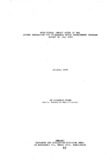Nutritional impact study of the income generation for vulnerable group development program: report of July 1995
Date
1995-10Publisher
BRAC Research and Evaluation Division (RED)Author
Hyder, S.M. ZiauddinMetadata
Show full item recordCitation
Hyder, S. M. Z. (1995, October). Nutritional impact study of the income generation for vulnerable group development program: report of July 1995. Research Reports (1995): Health Studies, Vol - XVIII, 69–85.Abstract
BRAC through its collaborative effort with the Government
of Bangladesh has been implementing the Income Generation
for Vulnerable Group Development Programme (IGVGDP) with
the aim of improving the destitute rural women's 1 i fe
through involving them into income generating and other
development activities. The participating women receive
31.25 kg wheat per month as food aid for a set period of
two years along with other development inputs from BRAC
and the GOB. Nutrition and other health messages are
imparted in the regularly held issue based meetings and
through home visits by the para-professionals and
programme field staff.
Nutritional status indicators have been considered as a
proxy of overall development of the programme
participating households. The aim of this study is to
see if the programme after about a year of postimplementation
has made any impact on the nutritional
status of the pre-school children.
This study is based on data collected in July 1995 on 202
Households participated In the IGVGD programme from
Tanga i 1 Sadar than a, 17 2 non-programme con t ro 1 househo Ids
from within the programme area and 164 non-programme
control households from outside the programme area
(Kalihati thana). The study children's anthropometric
and household's socioeconomic data were collected by the
RED interviewers through home visits using structured
pre-tested questionnaire.
The data suggest positive changes for some selected
socioeconomic indicators of the households participated
in the IGVGD programme compared to the control
households. Sanitary and hygiene practice were also
found to be better among the IGVGD households.
A decreased trend was found in the proportion of severely
malnourished children (according to Gomez classification)
in the programme househo Ids. Wasting as defined by
reduced weight for height was significantly lower in the
IGVGD households ( 7. 8%) ' compared to the non-programme
households from within (12.1%) and outside (18.9%) the
programme area. The proportion of the underweight
children was also lower in the programme children (63.8%)
than both the non-programme children (69.6% and 78.1%
respectively).
Examining the results of this study it may be concluded
that the IGVGD programme in addition to socioeconomic
upl i ftment of the rural destitute women is able to
improve nutritional status of the vulnerable groups such
as the pre-school children.

